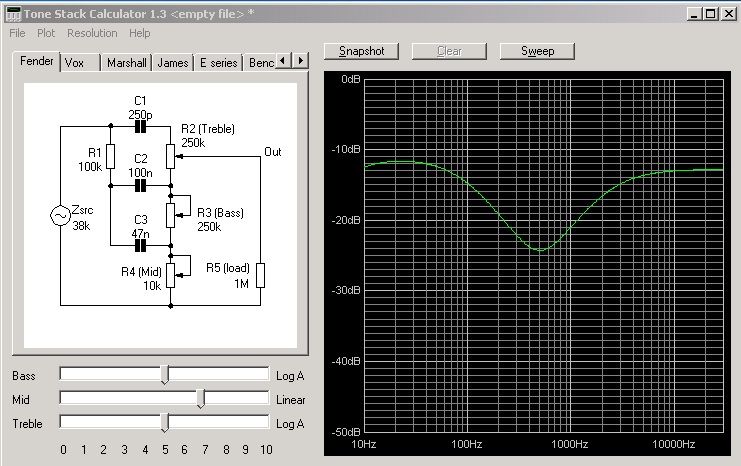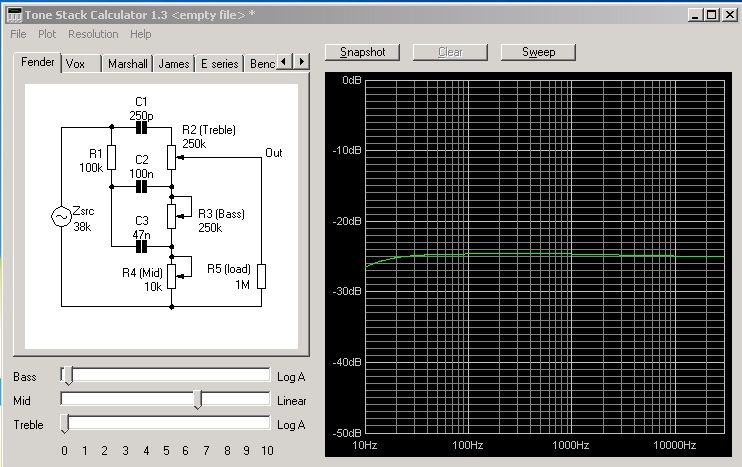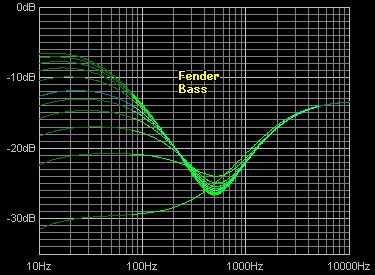-
does this mean i'm "old school" Patrick????
 Originally Posted by Patrick2
Originally Posted by Patrick2
cos yes i know what sound i like and can dial in something close to that on just about anything....and once i know how to get a particular guitar to sound how i like outa an amp i kinda do what Patrick mentioned as being old school.... basic setting is there and i just tweak a bit at a gig to compensate for the room and volume of a gig ...and btw i find on many fender tube amps i turned the tops considerably down and the bass often full ...
and a HUGE YES to fender tube amp tone for jazz (princeton/deluxe reverb) i even bought the boss FDR1 pedal to use into my solid state amps to get that fenderish tone ...and my gigs are only jazz
for me i reckon , long as you know what tone you want let your ears tell you whats the right settings .... no matter what they are or how they look .... and once you found your sound .... setups should be a 2 min affair
-
03-31-2014 04:47 AM
-
My solution to adjusting Fender tonestacks is that I just use Ampegs instead.
-
That is only true if your sound is a pure blackface sound. The EQ on those amps (unmodded) is pretty limited to bass and treble adjustment. If you want to add / remove mids there's nothing you can do - and a lot of the times the trick for a good sound is precisely in the mids. Again - if you love the scooped sound it's obviously easy to adjust a fender amp in 2m. If not... you need an eq pedal (or to mod the amp).
 Originally Posted by Keira Witherkay
Originally Posted by Keira Witherkay
-
Thank you Bob and everyone else who has contributed to this thread. You have helped me and many others to better understand jazz guitar amplification.
I prefer an amplified tone that sounds more like the guitar, than the amp. On the Evans RE200, a good way to adjust for a woody, neutral tone is to start with Bass 1, Body 3, Treble 1 and adjust up from there. Then, just like Goldielocks, it's easy to know where "just right" is after you've heard what "not enough" and "too much" sounds like.
Using a light string attack on chrome strings, Armstrong H.B.'s, with both the guitar's volume and tone controls rolled back about half way, my ears like these settings for a Comins 17" and a (Foster solid body):
Buff 2(4), Bass 2(5), Depth 2 (3) o'clock, Body 3(6), Expand 2(3) o'clock, Treble 1(5), Volume 3(4).
This indicates that larger bodied jazz guitars naturally produce stronger fundamental frequencies and therefore require lower amplifier tone control settings.
-
Thanks for this contribution, Scot. I and several ( at least) others here are Evans fans, and after recently putting my AH200 briefly up for sale here, I decided I couldn't part with it. But I have always wanted to know where the ''theoretical'' flat response spot is on Evans amps- the initial setting you suggest is useful, but sounds bass- thin to me.
 Originally Posted by Scot Buffington
Originally Posted by Scot Buffington
Can you help with that? One reason for asking this is that I tend to favour what I perceive as a slightly 'scooped' tone for solo playing, but i know from experience that this setting in a combo context, or for recording, can sound thin and lacking in mids. So, knowing where the 'flat response' spot is located could be a useful benchmark.
Incidentally on the AH200 it's a pity that the expand function is either on or off, rather than being adjustable. OTOH the buff control is a great innovation.
-
Scot,
I just checked my settings to see what I use with my archtop guitar.
Buff 2-3, Bass 3-4, Depth 11 o'clock, Body 3-4, Expand 9 o'clock, Treble 1-2
So very similar to what you like except I prefer less Expand than you.
:-)
Bob
 Originally Posted by Scot Buffington
Originally Posted by Scot Buffington
-
Thanks for your kind words. The bass should sound a little thin at 1 for most guitars. From there, simply turn up the Bass control until your low E string starts to get boomy and then back down one number. If you still want more low end, use the hotter +6dB Input.
Your Expand switch will also add bass and has been replaced by a control knob on units built since 2010. I like to use the Depth control to add low mids and balance the loudness between my low E and A strings. The Buff control is a high end boost that is located after all of the other tone controls to restore any signal loss from cables, effects or tone controls like Body. The Body control adds mids and rolls off highs when turned up.
At Evans, we've never given much thought to flat frequency responses, because we use passive not active tone controls. A flat response is useful with active tone controls to avoid intermodulation (muddy chords) distortion.
That's the reason I don't really know what a flat response setting for your AH200 is. However, I can tell you how to get a flat response for 90's and today's Evans amps. Unfortunately, you may find these settings to be a more useful benchmark for listening to a CD through your amp head.
Flat response for 1990's Evans amps:
Bass 9, Depth up, Body 9, Expand up, Treble 6
Flat response for 2010's Evans amps with Expand control:
Buff 1.5, Bass 10, Depth 30% on, Body 9.5, Expand full on, Treble 9
Your AH200 is closer to the 90's amps with a stronger Treble response than new Evans amplifiers. We have made major improvements since your amp was built. If your serial number starts with 08, 09, 10, then it can be upgraded to current shop standards. Feel free to email me for more details. Thanks again.
-
I'm going to be honest, I really like the way my guitar sounds when I plug it into my Fender BF and play. I have absolutely hated the way my guitar sounds after every studio engineer that I've worked with started messing around with EQ on a quest to make the lines on his monitor look better.
0-10-0 works good enough for me.
-
scott, i'd like to see you guys use more of a fender style tone stack in terms of the center frequencies of the controls. So if I want to get a george benson tone, I would just tweak the treble up to 6 or 7 and if I was going for '60s Joe Pass, I would tweak it down to 3 or 4.
I've owned a few evans amps and it seems to me that the treble control was not quite voiced in the right place. It seemed to be more of a high mid and when I increased it to add treble frequencies, I got some mid range nasally tone that I wasn't quite happy with.
-
Scot: I have a JE150 that I bought from you new in 1997 . . s/n 970821A. I'd be interested in the upgrade to current shop standards. I went on your web site and there is no "contact us" option. I also don't have your email address . . only a phone number that was on the original invoice.
 Originally Posted by Scot Buffington
Originally Posted by Scot Buffington
-
Patrick, there is a 'contact us' option on the home page. I'll also be asking about the upgrade option
Jack, I agree about the older amps but the new 'buff' function takes care of the treble in a very fenderish way, to my ears. It's reminiscent of the 'Presence' feedback loop on older fenders, and adds sparkle. I just leave the treble at 1.5 and use the Buff control for highs.
-
i played an evans several years ago with a buff (or was it scruff) control and didn't dig it. If I were evans, I'd bag the "body", "buff" and "scruff" knobs and just label them with guitar terms. But if the newer amps do have a better control over the 5k freq range, they would have a winner.
I still think ultimately, demeter has the best idea which is to marry a HV black face preamp with a class D amp.
Demeter creates the Mighty Minnie pedal board amp
-
Well if it was the scruff control, that's a mild distortion effect; but the more recent buff control works for me. YMMV.
-
Maybe it's just me? But, I've been all over their web site several times and can't seem to find the contact us link.?.?
 Originally Posted by Franz 1997
Originally Posted by Franz 1997
-
Go to evans home page. Locate ''follow us'' in the top menu bar. Look down the page about 4" ( maybe more if you have a big screen). 'Contact us' is there




-
I tried that before posting that the site doesn't have a contact us link. I tried every link on the site. I think it might be a browser problem. When I clicked on "follow us" . . it took me to a blank page. There is no scroll option. I can't move any of the pages on the site up or down. I'm going to try opening it in Firefox.
 Originally Posted by Franz 1997
Originally Posted by Franz 1997
-
here's an email address I have used before, a few years ago:
Scot Buffington - Evans Custom Amps <sbuffington@triad.rr.com>
or you could PM him
-
Bob, It's good to know that both of our Comins guitars require just about the same RE200 tone settings. The low A on my seven string sounds a little more like an upright bass to my ears with the low end boost of the Expand control.
Patrick2, thanks for pointing out that there is a problem with contact us on the Evansamps.com website. We have contact us information at the bottom of every page. However, I'll ask our web designer about adding a contact us button to the top of the home page.
The touring Evans amp is currently in Portland, OR. If anyone living in the Northwest US or Canada wants to test drive a new RE200 for a week, please call me at 336-270-5700 for more information. You can also email me at: evanscustomamps@gmail.com Thanks again.
-
Thank you so much for posting these charts and frequencies.
 Originally Posted by iim7V7IM7
Originally Posted by iim7V7IM7
I've been searching for this since I bought my bf reissue last year.
I hate the sound. To scooped and if not scooped then too nasally and choked.
Love the cleans hate the od.
I've tried my ts9 too nasally
My eq too nasally or fizzy
My muffs too fizzy or choked
The only pedal that's doable is my clon clone tumnus deluxe.
I do floyd so just got a hiwatt t20 now stuck with a beatifully blonde bf twin that I don't like the sound but love the look. Ohwell lol.
-
I like a little scooped sound. I play all my (non-mid knob) Fenders at T=5; B=5, with temporary going back at 4 minimum. I don't like them down below 4 and not at all in the 0-2 range. Because the sound gets mid-heavy and undefined, although it cuts better through the mix I guess. Many jazz players have a mid-heavy nasal tone IMO. No sparkle and full lows...
-
My BF settings are: bass from 2.5 to 3.5, depending on how loud I play, 7.5 mids and 4.5 highs.
These settings balance very well between squeaky cleans and light OD with either a Zendrive or a Fulltone OCD.
YMMV.




 Reply With Quote
Reply With Quote












2 new & excellent Jazz Comping Truefire...
Yesterday, 10:22 PM in Comping, Chords & Chord Progressions